Organisational Behaviour Analysis Report: Waitrose, Semester 1
VerifiedAdded on 2023/01/13
|15
|5088
|31
Report
AI Summary
This report provides a comprehensive analysis of organisational behaviour, focusing on the case of Waitrose. It delves into the key elements of organisational behaviour, including organisational culture, examining its impact on employee behaviour and company performance. The report explores different types of organisational cultures, such as role, task, person, and power cultures, and their relevance to Waitrose. It also examines the role of politics and power within the organisation, discussing the positive and negative impacts of various power dynamics. Furthermore, the report investigates motivational theories, including content and process theories, with a specific focus on Alderfer's ERG theory. The report also examines the application of Hofstede's cultural dimensions theory in the context of Waitrose. The report concludes with an evaluation of the impact of different organisational factors on team effectiveness and individual performance, offering insights into how Waitrose can improve its organisational behaviour practices.
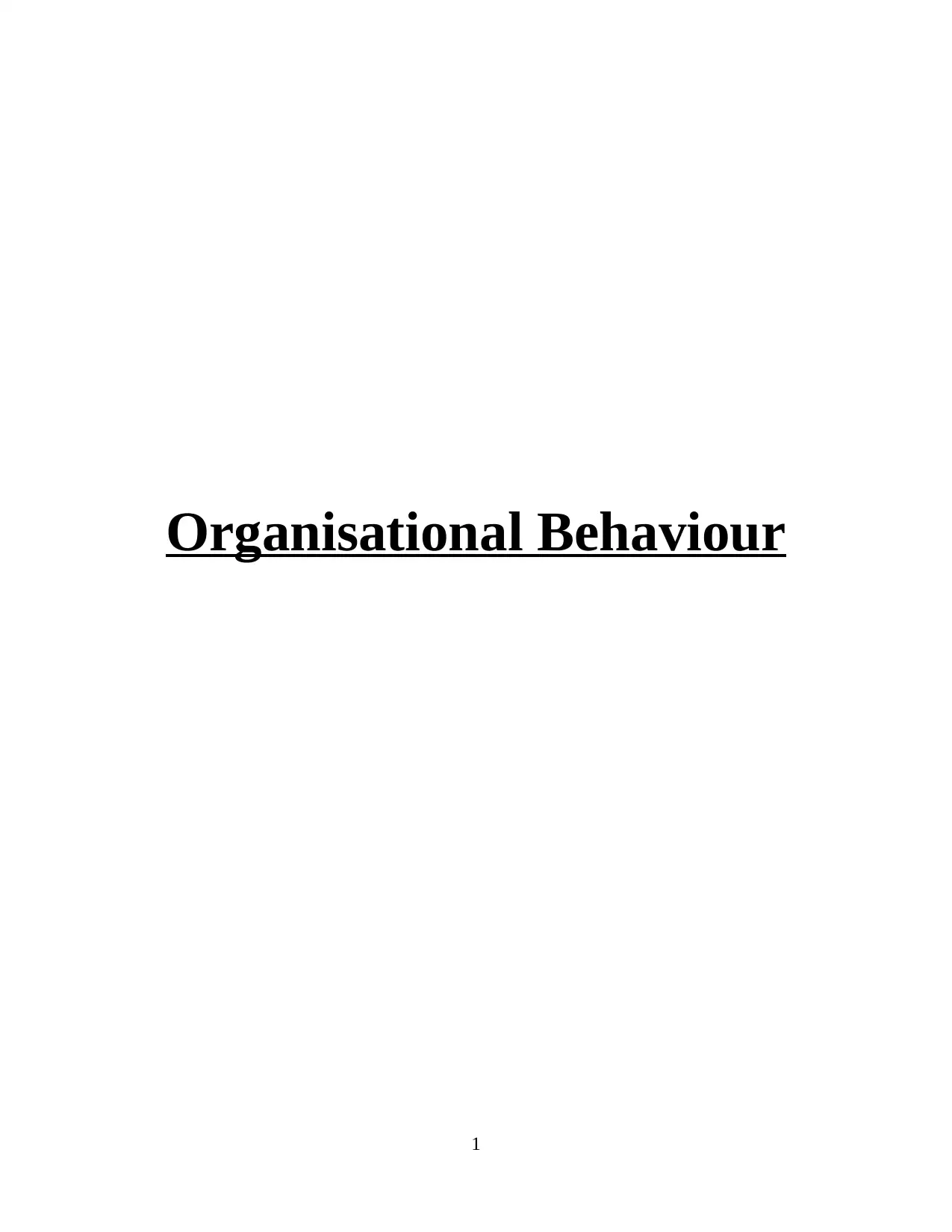
Organisational Behaviour
1
1
Paraphrase This Document
Need a fresh take? Get an instant paraphrase of this document with our AI Paraphraser
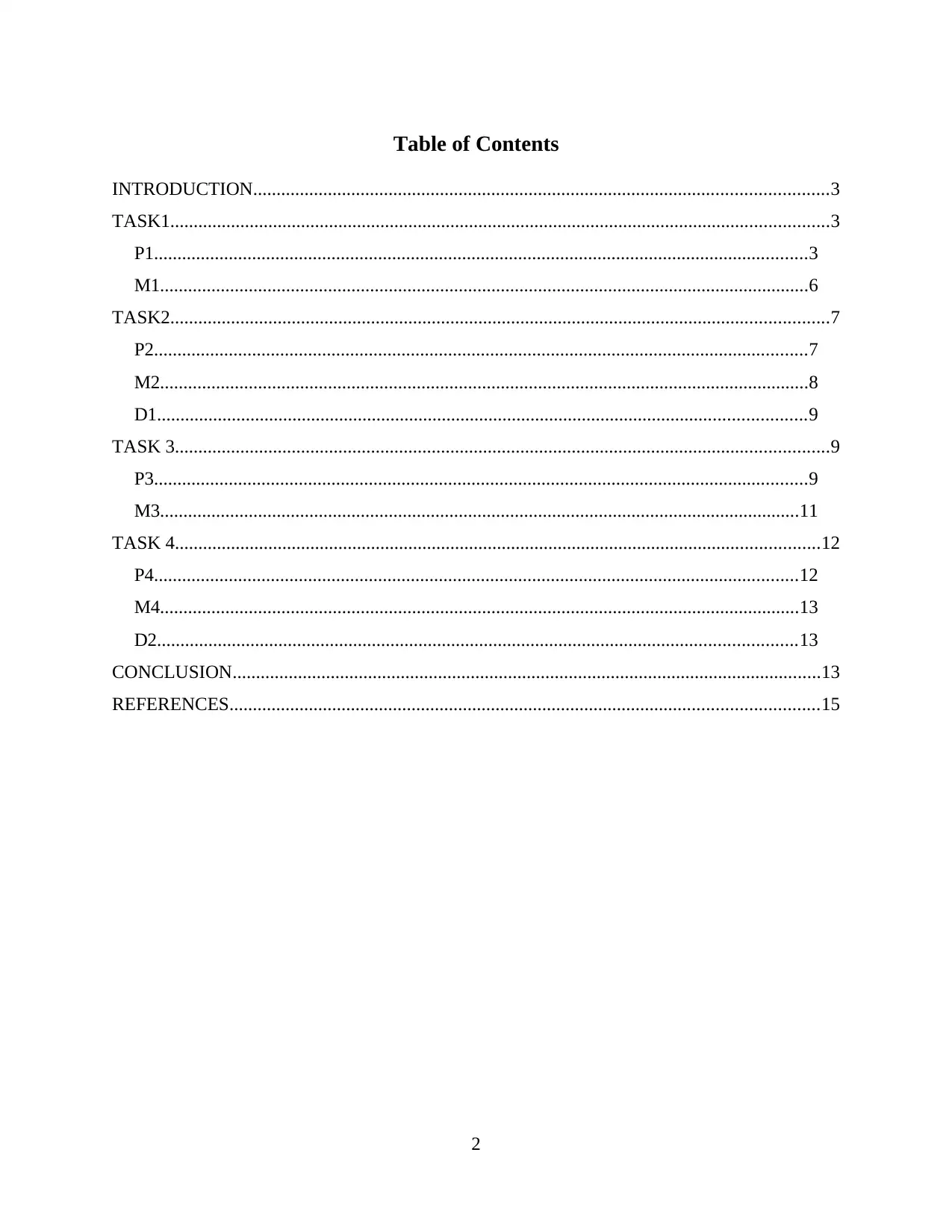
Table of Contents
INTRODUCTION...........................................................................................................................3
TASK1.............................................................................................................................................3
P1............................................................................................................................................3
M1...........................................................................................................................................6
TASK2.............................................................................................................................................7
P2............................................................................................................................................7
M2...........................................................................................................................................8
D1...........................................................................................................................................9
TASK 3............................................................................................................................................9
P3............................................................................................................................................9
M3.........................................................................................................................................11
TASK 4..........................................................................................................................................12
P4..........................................................................................................................................12
M4.........................................................................................................................................13
D2.........................................................................................................................................13
CONCLUSION..............................................................................................................................13
REFERENCES..............................................................................................................................15
2
INTRODUCTION...........................................................................................................................3
TASK1.............................................................................................................................................3
P1............................................................................................................................................3
M1...........................................................................................................................................6
TASK2.............................................................................................................................................7
P2............................................................................................................................................7
M2...........................................................................................................................................8
D1...........................................................................................................................................9
TASK 3............................................................................................................................................9
P3............................................................................................................................................9
M3.........................................................................................................................................11
TASK 4..........................................................................................................................................12
P4..........................................................................................................................................12
M4.........................................................................................................................................13
D2.........................................................................................................................................13
CONCLUSION..............................................................................................................................13
REFERENCES..............................................................................................................................15
2
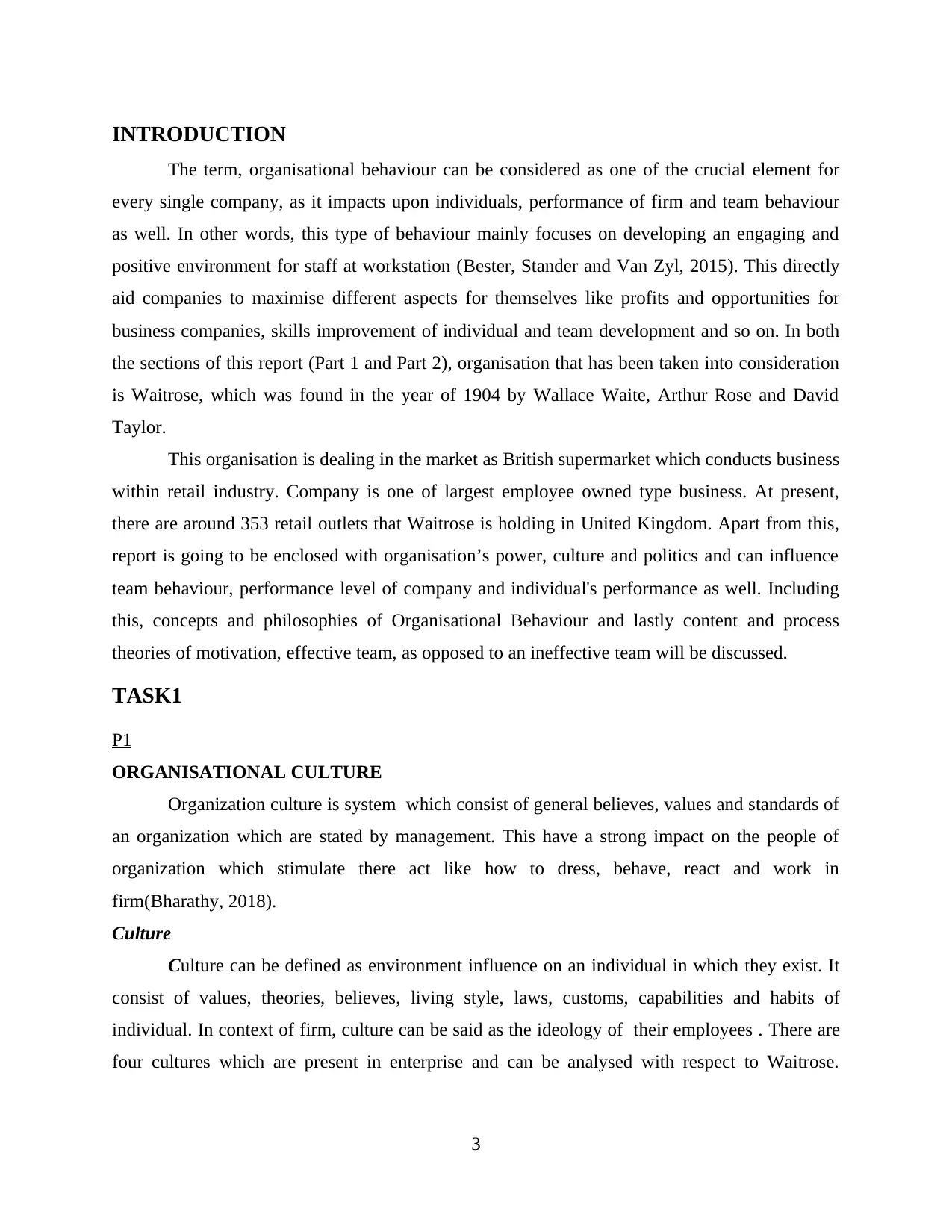
INTRODUCTION
The term, organisational behaviour can be considered as one of the crucial element for
every single company, as it impacts upon individuals, performance of firm and team behaviour
as well. In other words, this type of behaviour mainly focuses on developing an engaging and
positive environment for staff at workstation (Bester, Stander and Van Zyl, 2015). This directly
aid companies to maximise different aspects for themselves like profits and opportunities for
business companies, skills improvement of individual and team development and so on. In both
the sections of this report (Part 1 and Part 2), organisation that has been taken into consideration
is Waitrose, which was found in the year of 1904 by Wallace Waite, Arthur Rose and David
Taylor.
This organisation is dealing in the market as British supermarket which conducts business
within retail industry. Company is one of largest employee owned type business. At present,
there are around 353 retail outlets that Waitrose is holding in United Kingdom. Apart from this,
report is going to be enclosed with organisation’s power, culture and politics and can influence
team behaviour, performance level of company and individual's performance as well. Including
this, concepts and philosophies of Organisational Behaviour and lastly content and process
theories of motivation, effective team, as opposed to an ineffective team will be discussed.
TASK1
P1
ORGANISATIONAL CULTURE
Organization culture is system which consist of general believes, values and standards of
an organization which are stated by management. This have a strong impact on the people of
organization which stimulate there act like how to dress, behave, react and work in
firm(Bharathy, 2018).
Culture
Culture can be defined as environment influence on an individual in which they exist. It
consist of values, theories, believes, living style, laws, customs, capabilities and habits of
individual. In context of firm, culture can be said as the ideology of their employees . There are
four cultures which are present in enterprise and can be analysed with respect to Waitrose.
3
The term, organisational behaviour can be considered as one of the crucial element for
every single company, as it impacts upon individuals, performance of firm and team behaviour
as well. In other words, this type of behaviour mainly focuses on developing an engaging and
positive environment for staff at workstation (Bester, Stander and Van Zyl, 2015). This directly
aid companies to maximise different aspects for themselves like profits and opportunities for
business companies, skills improvement of individual and team development and so on. In both
the sections of this report (Part 1 and Part 2), organisation that has been taken into consideration
is Waitrose, which was found in the year of 1904 by Wallace Waite, Arthur Rose and David
Taylor.
This organisation is dealing in the market as British supermarket which conducts business
within retail industry. Company is one of largest employee owned type business. At present,
there are around 353 retail outlets that Waitrose is holding in United Kingdom. Apart from this,
report is going to be enclosed with organisation’s power, culture and politics and can influence
team behaviour, performance level of company and individual's performance as well. Including
this, concepts and philosophies of Organisational Behaviour and lastly content and process
theories of motivation, effective team, as opposed to an ineffective team will be discussed.
TASK1
P1
ORGANISATIONAL CULTURE
Organization culture is system which consist of general believes, values and standards of
an organization which are stated by management. This have a strong impact on the people of
organization which stimulate there act like how to dress, behave, react and work in
firm(Bharathy, 2018).
Culture
Culture can be defined as environment influence on an individual in which they exist. It
consist of values, theories, believes, living style, laws, customs, capabilities and habits of
individual. In context of firm, culture can be said as the ideology of their employees . There are
four cultures which are present in enterprise and can be analysed with respect to Waitrose.
3
⊘ This is a preview!⊘
Do you want full access?
Subscribe today to unlock all pages.

Trusted by 1+ million students worldwide
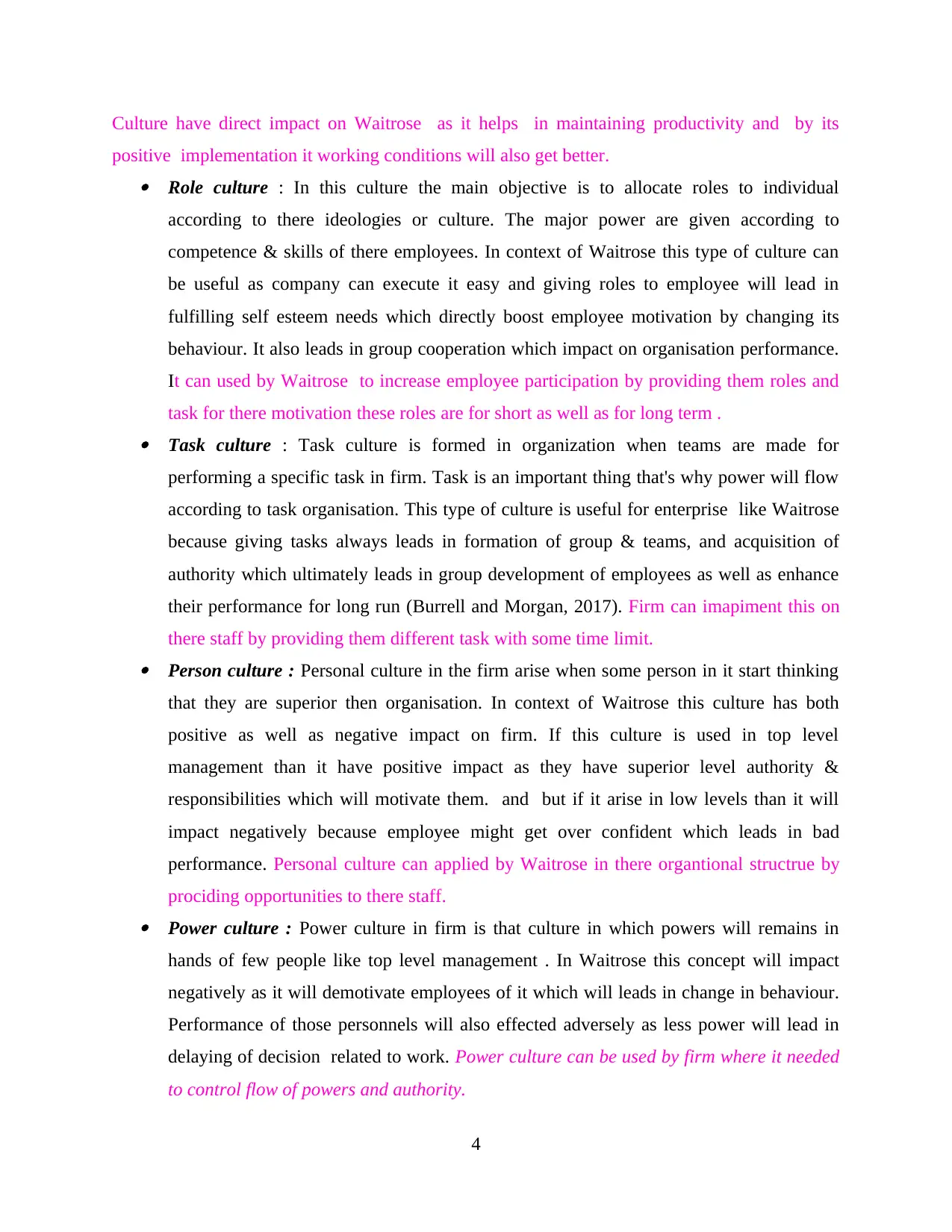
Culture have direct impact on Waitrose as it helps in maintaining productivity and by its
positive implementation it working conditions will also get better. Role culture : In this culture the main objective is to allocate roles to individual
according to there ideologies or culture. The major power are given according to
competence & skills of there employees. In context of Waitrose this type of culture can
be useful as company can execute it easy and giving roles to employee will lead in
fulfilling self esteem needs which directly boost employee motivation by changing its
behaviour. It also leads in group cooperation which impact on organisation performance.
It can used by Waitrose to increase employee participation by providing them roles and
task for there motivation these roles are for short as well as for long term . Task culture : Task culture is formed in organization when teams are made for
performing a specific task in firm. Task is an important thing that's why power will flow
according to task organisation. This type of culture is useful for enterprise like Waitrose
because giving tasks always leads in formation of group & teams, and acquisition of
authority which ultimately leads in group development of employees as well as enhance
their performance for long run (Burrell and Morgan, 2017). Firm can imapiment this on
there staff by providing them different task with some time limit. Person culture : Personal culture in the firm arise when some person in it start thinking
that they are superior then organisation. In context of Waitrose this culture has both
positive as well as negative impact on firm. If this culture is used in top level
management than it have positive impact as they have superior level authority &
responsibilities which will motivate them. and but if it arise in low levels than it will
impact negatively because employee might get over confident which leads in bad
performance. Personal culture can applied by Waitrose in there organtional structrue by
prociding opportunities to there staff. Power culture : Power culture in firm is that culture in which powers will remains in
hands of few people like top level management . In Waitrose this concept will impact
negatively as it will demotivate employees of it which will leads in change in behaviour.
Performance of those personnels will also effected adversely as less power will lead in
delaying of decision related to work. Power culture can be used by firm where it needed
to control flow of powers and authority.
4
positive implementation it working conditions will also get better. Role culture : In this culture the main objective is to allocate roles to individual
according to there ideologies or culture. The major power are given according to
competence & skills of there employees. In context of Waitrose this type of culture can
be useful as company can execute it easy and giving roles to employee will lead in
fulfilling self esteem needs which directly boost employee motivation by changing its
behaviour. It also leads in group cooperation which impact on organisation performance.
It can used by Waitrose to increase employee participation by providing them roles and
task for there motivation these roles are for short as well as for long term . Task culture : Task culture is formed in organization when teams are made for
performing a specific task in firm. Task is an important thing that's why power will flow
according to task organisation. This type of culture is useful for enterprise like Waitrose
because giving tasks always leads in formation of group & teams, and acquisition of
authority which ultimately leads in group development of employees as well as enhance
their performance for long run (Burrell and Morgan, 2017). Firm can imapiment this on
there staff by providing them different task with some time limit. Person culture : Personal culture in the firm arise when some person in it start thinking
that they are superior then organisation. In context of Waitrose this culture has both
positive as well as negative impact on firm. If this culture is used in top level
management than it have positive impact as they have superior level authority &
responsibilities which will motivate them. and but if it arise in low levels than it will
impact negatively because employee might get over confident which leads in bad
performance. Personal culture can applied by Waitrose in there organtional structrue by
prociding opportunities to there staff. Power culture : Power culture in firm is that culture in which powers will remains in
hands of few people like top level management . In Waitrose this concept will impact
negatively as it will demotivate employees of it which will leads in change in behaviour.
Performance of those personnels will also effected adversely as less power will lead in
delaying of decision related to work. Power culture can be used by firm where it needed
to control flow of powers and authority.
4
Paraphrase This Document
Need a fresh take? Get an instant paraphrase of this document with our AI Paraphraser
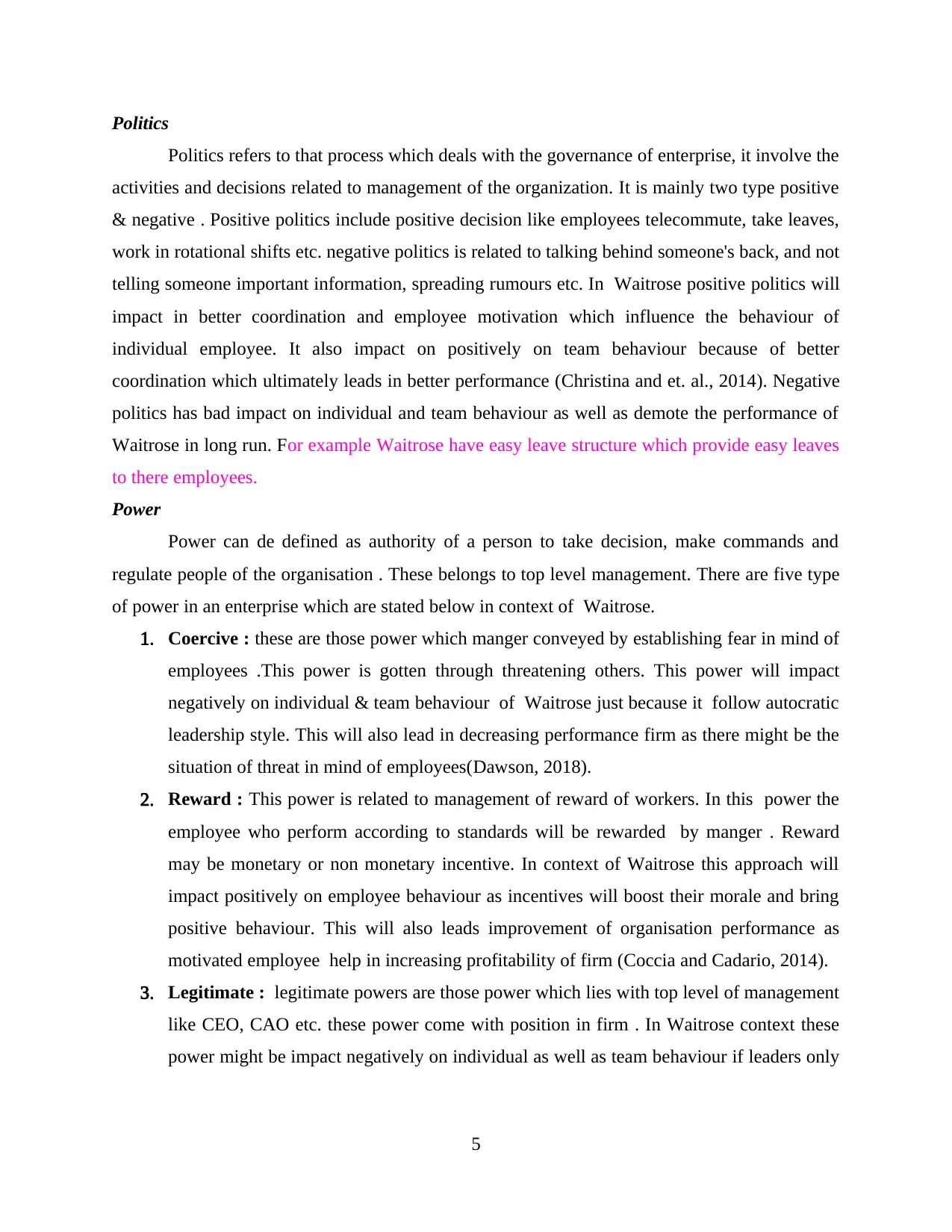
Politics
Politics refers to that process which deals with the governance of enterprise, it involve the
activities and decisions related to management of the organization. It is mainly two type positive
& negative . Positive politics include positive decision like employees telecommute, take leaves,
work in rotational shifts etc. negative politics is related to talking behind someone's back, and not
telling someone important information, spreading rumours etc. In Waitrose positive politics will
impact in better coordination and employee motivation which influence the behaviour of
individual employee. It also impact on positively on team behaviour because of better
coordination which ultimately leads in better performance (Christina and et. al., 2014). Negative
politics has bad impact on individual and team behaviour as well as demote the performance of
Waitrose in long run. For example Waitrose have easy leave structure which provide easy leaves
to there employees.
Power
Power can de defined as authority of a person to take decision, make commands and
regulate people of the organisation . These belongs to top level management. There are five type
of power in an enterprise which are stated below in context of Waitrose.
1. Coercive : these are those power which manger conveyed by establishing fear in mind of
employees .This power is gotten through threatening others. This power will impact
negatively on individual & team behaviour of Waitrose just because it follow autocratic
leadership style. This will also lead in decreasing performance firm as there might be the
situation of threat in mind of employees(Dawson, 2018).
2. Reward : This power is related to management of reward of workers. In this power the
employee who perform according to standards will be rewarded by manger . Reward
may be monetary or non monetary incentive. In context of Waitrose this approach will
impact positively on employee behaviour as incentives will boost their morale and bring
positive behaviour. This will also leads improvement of organisation performance as
motivated employee help in increasing profitability of firm (Coccia and Cadario, 2014).
3. Legitimate : legitimate powers are those power which lies with top level of management
like CEO, CAO etc. these power come with position in firm . In Waitrose context these
power might be impact negatively on individual as well as team behaviour if leaders only
5
Politics refers to that process which deals with the governance of enterprise, it involve the
activities and decisions related to management of the organization. It is mainly two type positive
& negative . Positive politics include positive decision like employees telecommute, take leaves,
work in rotational shifts etc. negative politics is related to talking behind someone's back, and not
telling someone important information, spreading rumours etc. In Waitrose positive politics will
impact in better coordination and employee motivation which influence the behaviour of
individual employee. It also impact on positively on team behaviour because of better
coordination which ultimately leads in better performance (Christina and et. al., 2014). Negative
politics has bad impact on individual and team behaviour as well as demote the performance of
Waitrose in long run. For example Waitrose have easy leave structure which provide easy leaves
to there employees.
Power
Power can de defined as authority of a person to take decision, make commands and
regulate people of the organisation . These belongs to top level management. There are five type
of power in an enterprise which are stated below in context of Waitrose.
1. Coercive : these are those power which manger conveyed by establishing fear in mind of
employees .This power is gotten through threatening others. This power will impact
negatively on individual & team behaviour of Waitrose just because it follow autocratic
leadership style. This will also lead in decreasing performance firm as there might be the
situation of threat in mind of employees(Dawson, 2018).
2. Reward : This power is related to management of reward of workers. In this power the
employee who perform according to standards will be rewarded by manger . Reward
may be monetary or non monetary incentive. In context of Waitrose this approach will
impact positively on employee behaviour as incentives will boost their morale and bring
positive behaviour. This will also leads improvement of organisation performance as
motivated employee help in increasing profitability of firm (Coccia and Cadario, 2014).
3. Legitimate : legitimate powers are those power which lies with top level of management
like CEO, CAO etc. these power come with position in firm . In Waitrose context these
power might be impact negatively on individual as well as team behaviour if leaders only
5
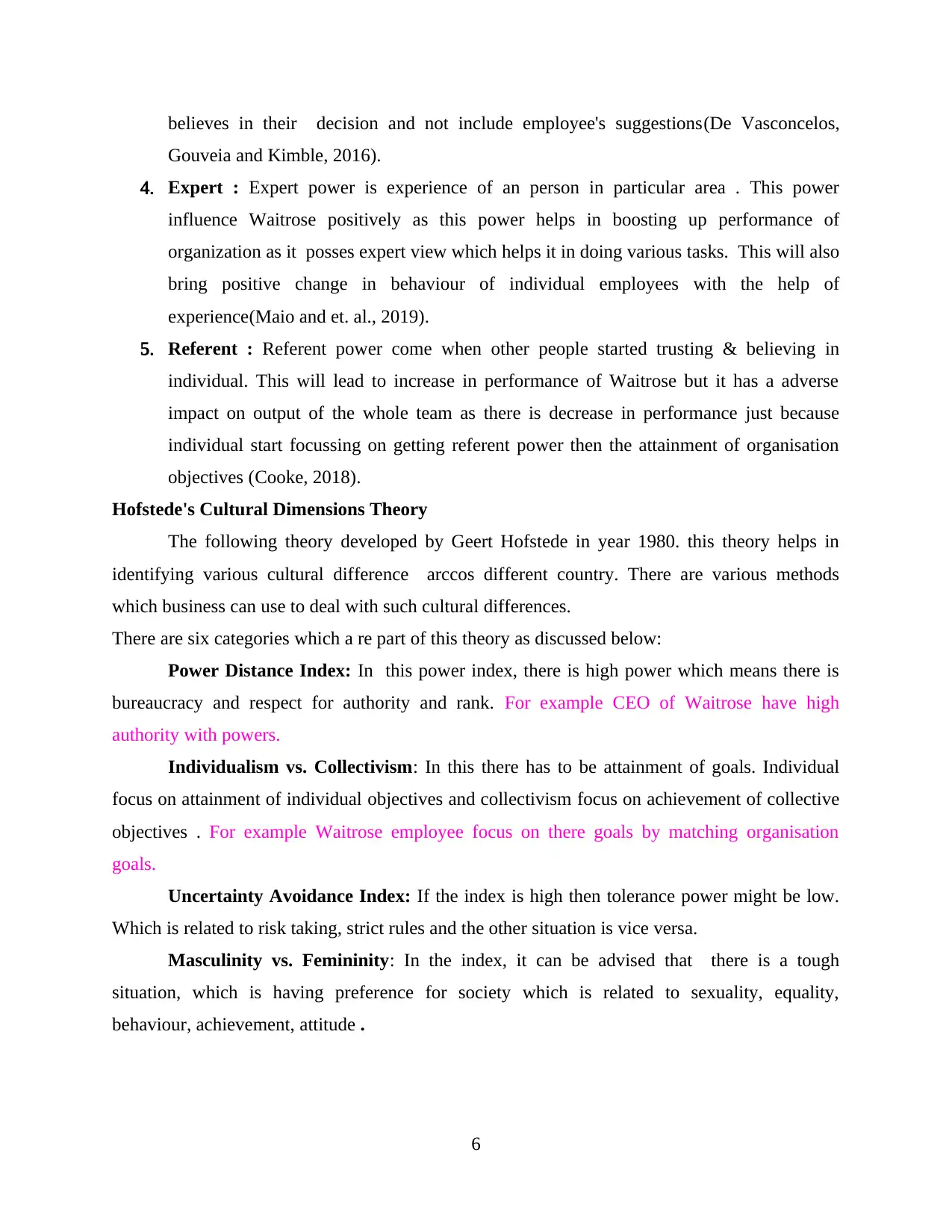
believes in their decision and not include employee's suggestions(De Vasconcelos,
Gouveia and Kimble, 2016).
4. Expert : Expert power is experience of an person in particular area . This power
influence Waitrose positively as this power helps in boosting up performance of
organization as it posses expert view which helps it in doing various tasks. This will also
bring positive change in behaviour of individual employees with the help of
experience(Maio and et. al., 2019).
5. Referent : Referent power come when other people started trusting & believing in
individual. This will lead to increase in performance of Waitrose but it has a adverse
impact on output of the whole team as there is decrease in performance just because
individual start focussing on getting referent power then the attainment of organisation
objectives (Cooke, 2018).
Hofstede's Cultural Dimensions Theory
The following theory developed by Geert Hofstede in year 1980. this theory helps in
identifying various cultural difference arccos different country. There are various methods
which business can use to deal with such cultural differences.
There are six categories which a re part of this theory as discussed below:
Power Distance Index: In this power index, there is high power which means there is
bureaucracy and respect for authority and rank. For example CEO of Waitrose have high
authority with powers.
Individualism vs. Collectivism: In this there has to be attainment of goals. Individual
focus on attainment of individual objectives and collectivism focus on achievement of collective
objectives . For example Waitrose employee focus on there goals by matching organisation
goals.
Uncertainty Avoidance Index: If the index is high then tolerance power might be low.
Which is related to risk taking, strict rules and the other situation is vice versa.
Masculinity vs. Femininity: In the index, it can be advised that there is a tough
situation, which is having preference for society which is related to sexuality, equality,
behaviour, achievement, attitude .
6
Gouveia and Kimble, 2016).
4. Expert : Expert power is experience of an person in particular area . This power
influence Waitrose positively as this power helps in boosting up performance of
organization as it posses expert view which helps it in doing various tasks. This will also
bring positive change in behaviour of individual employees with the help of
experience(Maio and et. al., 2019).
5. Referent : Referent power come when other people started trusting & believing in
individual. This will lead to increase in performance of Waitrose but it has a adverse
impact on output of the whole team as there is decrease in performance just because
individual start focussing on getting referent power then the attainment of organisation
objectives (Cooke, 2018).
Hofstede's Cultural Dimensions Theory
The following theory developed by Geert Hofstede in year 1980. this theory helps in
identifying various cultural difference arccos different country. There are various methods
which business can use to deal with such cultural differences.
There are six categories which a re part of this theory as discussed below:
Power Distance Index: In this power index, there is high power which means there is
bureaucracy and respect for authority and rank. For example CEO of Waitrose have high
authority with powers.
Individualism vs. Collectivism: In this there has to be attainment of goals. Individual
focus on attainment of individual objectives and collectivism focus on achievement of collective
objectives . For example Waitrose employee focus on there goals by matching organisation
goals.
Uncertainty Avoidance Index: If the index is high then tolerance power might be low.
Which is related to risk taking, strict rules and the other situation is vice versa.
Masculinity vs. Femininity: In the index, it can be advised that there is a tough
situation, which is having preference for society which is related to sexuality, equality,
behaviour, achievement, attitude .
6
⊘ This is a preview!⊘
Do you want full access?
Subscribe today to unlock all pages.

Trusted by 1+ million students worldwide
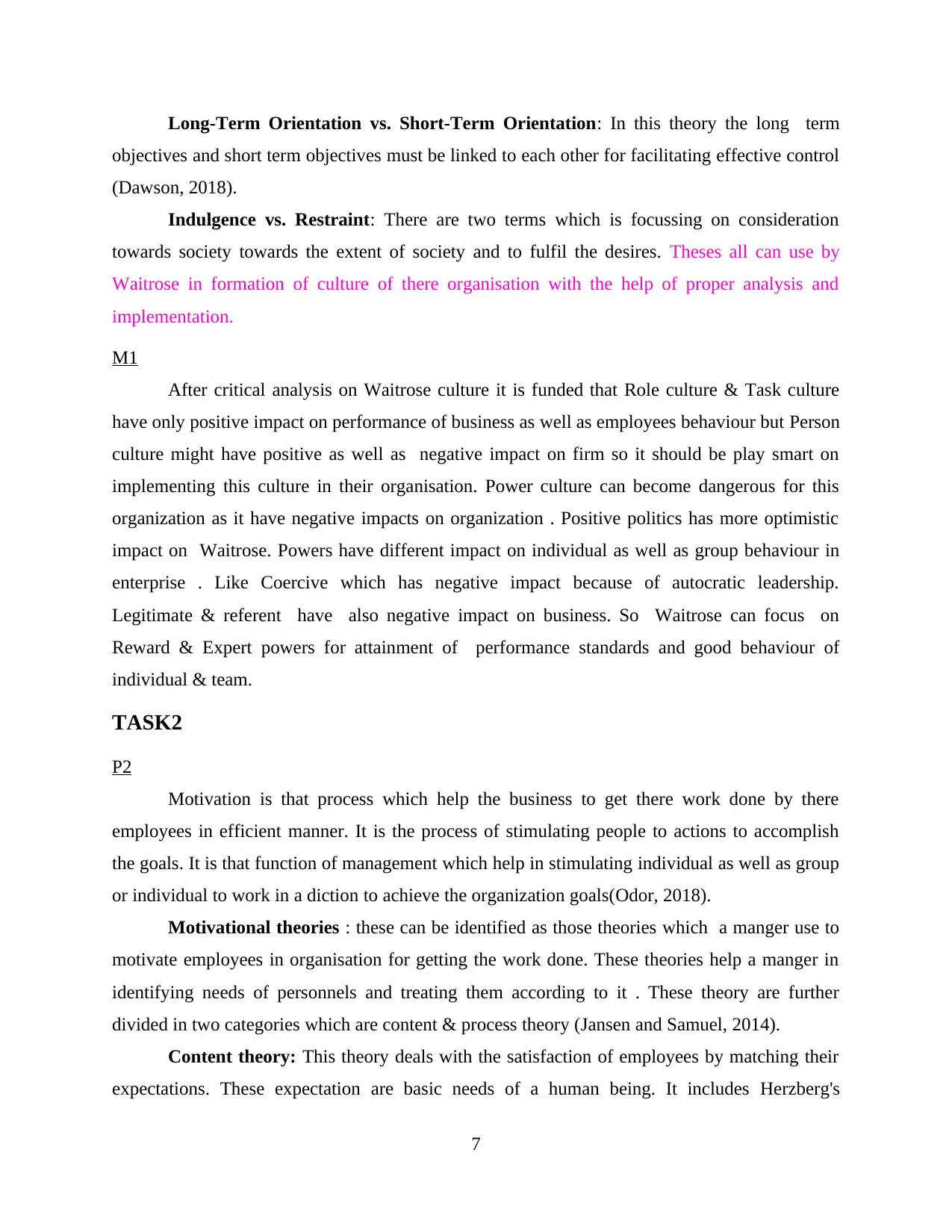
Long-Term Orientation vs. Short-Term Orientation: In this theory the long term
objectives and short term objectives must be linked to each other for facilitating effective control
(Dawson, 2018).
Indulgence vs. Restraint: There are two terms which is focussing on consideration
towards society towards the extent of society and to fulfil the desires. Theses all can use by
Waitrose in formation of culture of there organisation with the help of proper analysis and
implementation.
M1
After critical analysis on Waitrose culture it is funded that Role culture & Task culture
have only positive impact on performance of business as well as employees behaviour but Person
culture might have positive as well as negative impact on firm so it should be play smart on
implementing this culture in their organisation. Power culture can become dangerous for this
organization as it have negative impacts on organization . Positive politics has more optimistic
impact on Waitrose. Powers have different impact on individual as well as group behaviour in
enterprise . Like Coercive which has negative impact because of autocratic leadership.
Legitimate & referent have also negative impact on business. So Waitrose can focus on
Reward & Expert powers for attainment of performance standards and good behaviour of
individual & team.
TASK2
P2
Motivation is that process which help the business to get there work done by there
employees in efficient manner. It is the process of stimulating people to actions to accomplish
the goals. It is that function of management which help in stimulating individual as well as group
or individual to work in a diction to achieve the organization goals(Odor, 2018).
Motivational theories : these can be identified as those theories which a manger use to
motivate employees in organisation for getting the work done. These theories help a manger in
identifying needs of personnels and treating them according to it . These theory are further
divided in two categories which are content & process theory (Jansen and Samuel, 2014).
Content theory: This theory deals with the satisfaction of employees by matching their
expectations. These expectation are basic needs of a human being. It includes Herzberg's
7
objectives and short term objectives must be linked to each other for facilitating effective control
(Dawson, 2018).
Indulgence vs. Restraint: There are two terms which is focussing on consideration
towards society towards the extent of society and to fulfil the desires. Theses all can use by
Waitrose in formation of culture of there organisation with the help of proper analysis and
implementation.
M1
After critical analysis on Waitrose culture it is funded that Role culture & Task culture
have only positive impact on performance of business as well as employees behaviour but Person
culture might have positive as well as negative impact on firm so it should be play smart on
implementing this culture in their organisation. Power culture can become dangerous for this
organization as it have negative impacts on organization . Positive politics has more optimistic
impact on Waitrose. Powers have different impact on individual as well as group behaviour in
enterprise . Like Coercive which has negative impact because of autocratic leadership.
Legitimate & referent have also negative impact on business. So Waitrose can focus on
Reward & Expert powers for attainment of performance standards and good behaviour of
individual & team.
TASK2
P2
Motivation is that process which help the business to get there work done by there
employees in efficient manner. It is the process of stimulating people to actions to accomplish
the goals. It is that function of management which help in stimulating individual as well as group
or individual to work in a diction to achieve the organization goals(Odor, 2018).
Motivational theories : these can be identified as those theories which a manger use to
motivate employees in organisation for getting the work done. These theories help a manger in
identifying needs of personnels and treating them according to it . These theory are further
divided in two categories which are content & process theory (Jansen and Samuel, 2014).
Content theory: This theory deals with the satisfaction of employees by matching their
expectations. These expectation are basic needs of a human being. It includes Herzberg's
7
Paraphrase This Document
Need a fresh take? Get an instant paraphrase of this document with our AI Paraphraser
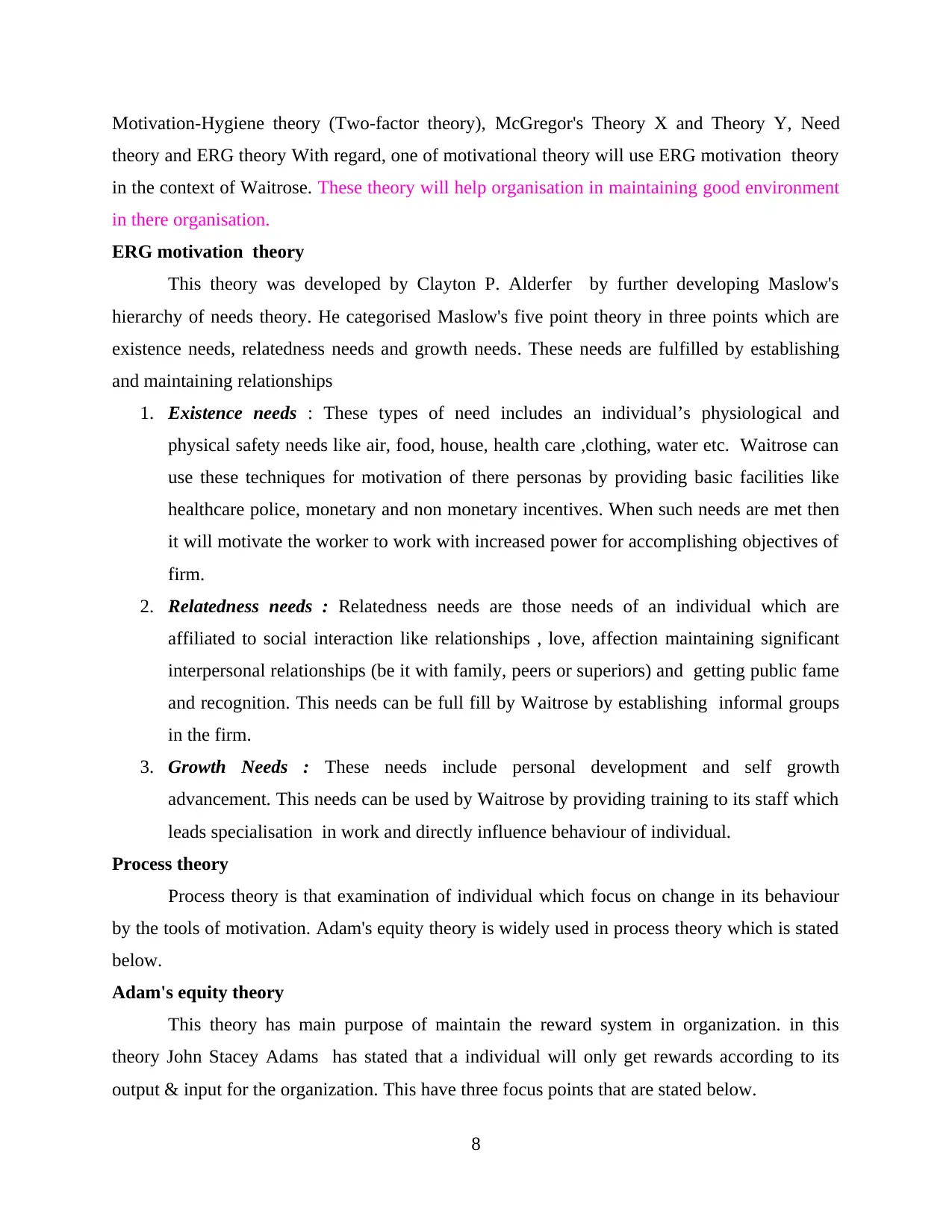
Motivation-Hygiene theory (Two-factor theory), McGregor's Theory X and Theory Y, Need
theory and ERG theory With regard, one of motivational theory will use ERG motivation theory
in the context of Waitrose. These theory will help organisation in maintaining good environment
in there organisation.
ERG motivation theory
This theory was developed by Clayton P. Alderfer by further developing Maslow's
hierarchy of needs theory. He categorised Maslow's five point theory in three points which are
existence needs, relatedness needs and growth needs. These needs are fulfilled by establishing
and maintaining relationships
1. Existence needs : These types of need includes an individual’s physiological and
physical safety needs like air, food, house, health care ,clothing, water etc. Waitrose can
use these techniques for motivation of there personas by providing basic facilities like
healthcare police, monetary and non monetary incentives. When such needs are met then
it will motivate the worker to work with increased power for accomplishing objectives of
firm.
2. Relatedness needs : Relatedness needs are those needs of an individual which are
affiliated to social interaction like relationships , love, affection maintaining significant
interpersonal relationships (be it with family, peers or superiors) and getting public fame
and recognition. This needs can be full fill by Waitrose by establishing informal groups
in the firm.
3. Growth Needs : These needs include personal development and self growth
advancement. This needs can be used by Waitrose by providing training to its staff which
leads specialisation in work and directly influence behaviour of individual.
Process theory
Process theory is that examination of individual which focus on change in its behaviour
by the tools of motivation. Adam's equity theory is widely used in process theory which is stated
below.
Adam's equity theory
This theory has main purpose of maintain the reward system in organization. in this
theory John Stacey Adams has stated that a individual will only get rewards according to its
output & input for the organization. This have three focus points that are stated below.
8
theory and ERG theory With regard, one of motivational theory will use ERG motivation theory
in the context of Waitrose. These theory will help organisation in maintaining good environment
in there organisation.
ERG motivation theory
This theory was developed by Clayton P. Alderfer by further developing Maslow's
hierarchy of needs theory. He categorised Maslow's five point theory in three points which are
existence needs, relatedness needs and growth needs. These needs are fulfilled by establishing
and maintaining relationships
1. Existence needs : These types of need includes an individual’s physiological and
physical safety needs like air, food, house, health care ,clothing, water etc. Waitrose can
use these techniques for motivation of there personas by providing basic facilities like
healthcare police, monetary and non monetary incentives. When such needs are met then
it will motivate the worker to work with increased power for accomplishing objectives of
firm.
2. Relatedness needs : Relatedness needs are those needs of an individual which are
affiliated to social interaction like relationships , love, affection maintaining significant
interpersonal relationships (be it with family, peers or superiors) and getting public fame
and recognition. This needs can be full fill by Waitrose by establishing informal groups
in the firm.
3. Growth Needs : These needs include personal development and self growth
advancement. This needs can be used by Waitrose by providing training to its staff which
leads specialisation in work and directly influence behaviour of individual.
Process theory
Process theory is that examination of individual which focus on change in its behaviour
by the tools of motivation. Adam's equity theory is widely used in process theory which is stated
below.
Adam's equity theory
This theory has main purpose of maintain the reward system in organization. in this
theory John Stacey Adams has stated that a individual will only get rewards according to its
output & input for the organization. This have three focus points that are stated below.
8
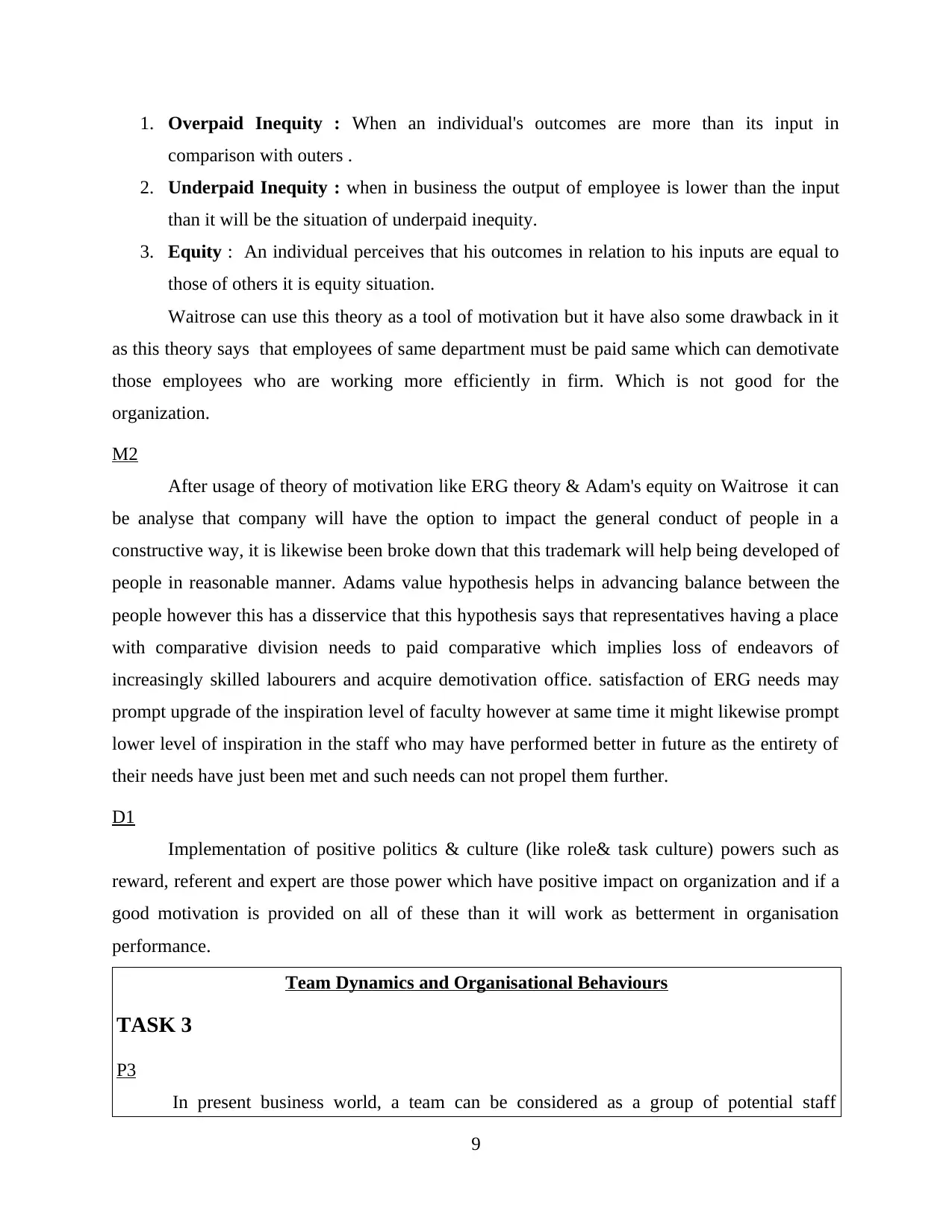
1. Overpaid Inequity : When an individual's outcomes are more than its input in
comparison with outers .
2. Underpaid Inequity : when in business the output of employee is lower than the input
than it will be the situation of underpaid inequity.
3. Equity : An individual perceives that his outcomes in relation to his inputs are equal to
those of others it is equity situation.
Waitrose can use this theory as a tool of motivation but it have also some drawback in it
as this theory says that employees of same department must be paid same which can demotivate
those employees who are working more efficiently in firm. Which is not good for the
organization.
M2
After usage of theory of motivation like ERG theory & Adam's equity on Waitrose it can
be analyse that company will have the option to impact the general conduct of people in a
constructive way, it is likewise been broke down that this trademark will help being developed of
people in reasonable manner. Adams value hypothesis helps in advancing balance between the
people however this has a disservice that this hypothesis says that representatives having a place
with comparative division needs to paid comparative which implies loss of endeavors of
increasingly skilled labourers and acquire demotivation office. satisfaction of ERG needs may
prompt upgrade of the inspiration level of faculty however at same time it might likewise prompt
lower level of inspiration in the staff who may have performed better in future as the entirety of
their needs have just been met and such needs can not propel them further.
D1
Implementation of positive politics & culture (like role& task culture) powers such as
reward, referent and expert are those power which have positive impact on organization and if a
good motivation is provided on all of these than it will work as betterment in organisation
performance.
Team Dynamics and Organisational Behaviours
TASK 3
P3
In present business world, a team can be considered as a group of potential staff
9
comparison with outers .
2. Underpaid Inequity : when in business the output of employee is lower than the input
than it will be the situation of underpaid inequity.
3. Equity : An individual perceives that his outcomes in relation to his inputs are equal to
those of others it is equity situation.
Waitrose can use this theory as a tool of motivation but it have also some drawback in it
as this theory says that employees of same department must be paid same which can demotivate
those employees who are working more efficiently in firm. Which is not good for the
organization.
M2
After usage of theory of motivation like ERG theory & Adam's equity on Waitrose it can
be analyse that company will have the option to impact the general conduct of people in a
constructive way, it is likewise been broke down that this trademark will help being developed of
people in reasonable manner. Adams value hypothesis helps in advancing balance between the
people however this has a disservice that this hypothesis says that representatives having a place
with comparative division needs to paid comparative which implies loss of endeavors of
increasingly skilled labourers and acquire demotivation office. satisfaction of ERG needs may
prompt upgrade of the inspiration level of faculty however at same time it might likewise prompt
lower level of inspiration in the staff who may have performed better in future as the entirety of
their needs have just been met and such needs can not propel them further.
D1
Implementation of positive politics & culture (like role& task culture) powers such as
reward, referent and expert are those power which have positive impact on organization and if a
good motivation is provided on all of these than it will work as betterment in organisation
performance.
Team Dynamics and Organisational Behaviours
TASK 3
P3
In present business world, a team can be considered as a group of potential staff
9
⊘ This is a preview!⊘
Do you want full access?
Subscribe today to unlock all pages.

Trusted by 1+ million students worldwide
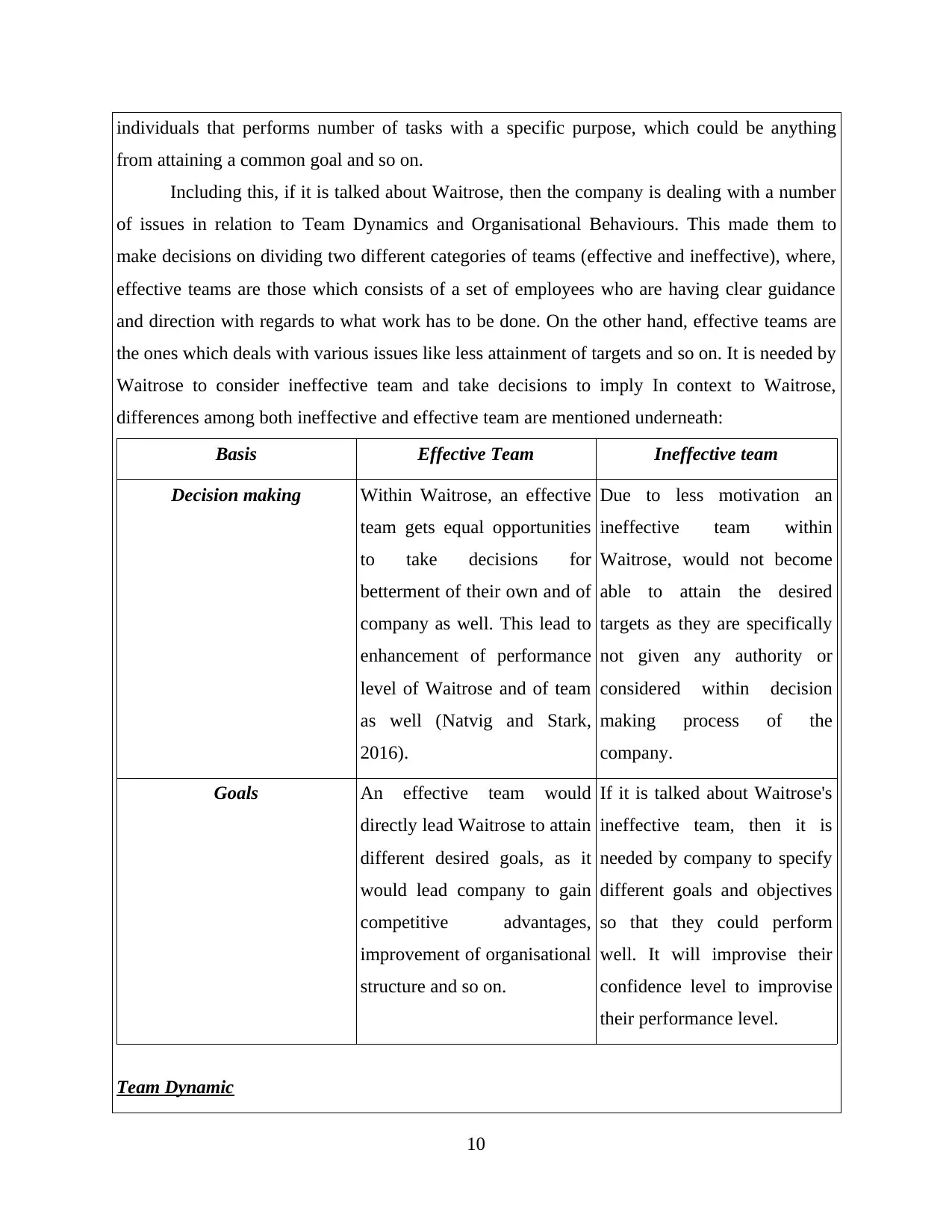
individuals that performs number of tasks with a specific purpose, which could be anything
from attaining a common goal and so on.
Including this, if it is talked about Waitrose, then the company is dealing with a number
of issues in relation to Team Dynamics and Organisational Behaviours. This made them to
make decisions on dividing two different categories of teams (effective and ineffective), where,
effective teams are those which consists of a set of employees who are having clear guidance
and direction with regards to what work has to be done. On the other hand, effective teams are
the ones which deals with various issues like less attainment of targets and so on. It is needed by
Waitrose to consider ineffective team and take decisions to imply In context to Waitrose,
differences among both ineffective and effective team are mentioned underneath:
Basis Effective Team Ineffective team
Decision making Within Waitrose, an effective
team gets equal opportunities
to take decisions for
betterment of their own and of
company as well. This lead to
enhancement of performance
level of Waitrose and of team
as well (Natvig and Stark,
2016).
Due to less motivation an
ineffective team within
Waitrose, would not become
able to attain the desired
targets as they are specifically
not given any authority or
considered within decision
making process of the
company.
Goals An effective team would
directly lead Waitrose to attain
different desired goals, as it
would lead company to gain
competitive advantages,
improvement of organisational
structure and so on.
If it is talked about Waitrose's
ineffective team, then it is
needed by company to specify
different goals and objectives
so that they could perform
well. It will improvise their
confidence level to improvise
their performance level.
Team Dynamic
10
from attaining a common goal and so on.
Including this, if it is talked about Waitrose, then the company is dealing with a number
of issues in relation to Team Dynamics and Organisational Behaviours. This made them to
make decisions on dividing two different categories of teams (effective and ineffective), where,
effective teams are those which consists of a set of employees who are having clear guidance
and direction with regards to what work has to be done. On the other hand, effective teams are
the ones which deals with various issues like less attainment of targets and so on. It is needed by
Waitrose to consider ineffective team and take decisions to imply In context to Waitrose,
differences among both ineffective and effective team are mentioned underneath:
Basis Effective Team Ineffective team
Decision making Within Waitrose, an effective
team gets equal opportunities
to take decisions for
betterment of their own and of
company as well. This lead to
enhancement of performance
level of Waitrose and of team
as well (Natvig and Stark,
2016).
Due to less motivation an
ineffective team within
Waitrose, would not become
able to attain the desired
targets as they are specifically
not given any authority or
considered within decision
making process of the
company.
Goals An effective team would
directly lead Waitrose to attain
different desired goals, as it
would lead company to gain
competitive advantages,
improvement of organisational
structure and so on.
If it is talked about Waitrose's
ineffective team, then it is
needed by company to specify
different goals and objectives
so that they could perform
well. It will improvise their
confidence level to improvise
their performance level.
Team Dynamic
10
Paraphrase This Document
Need a fresh take? Get an instant paraphrase of this document with our AI Paraphraser
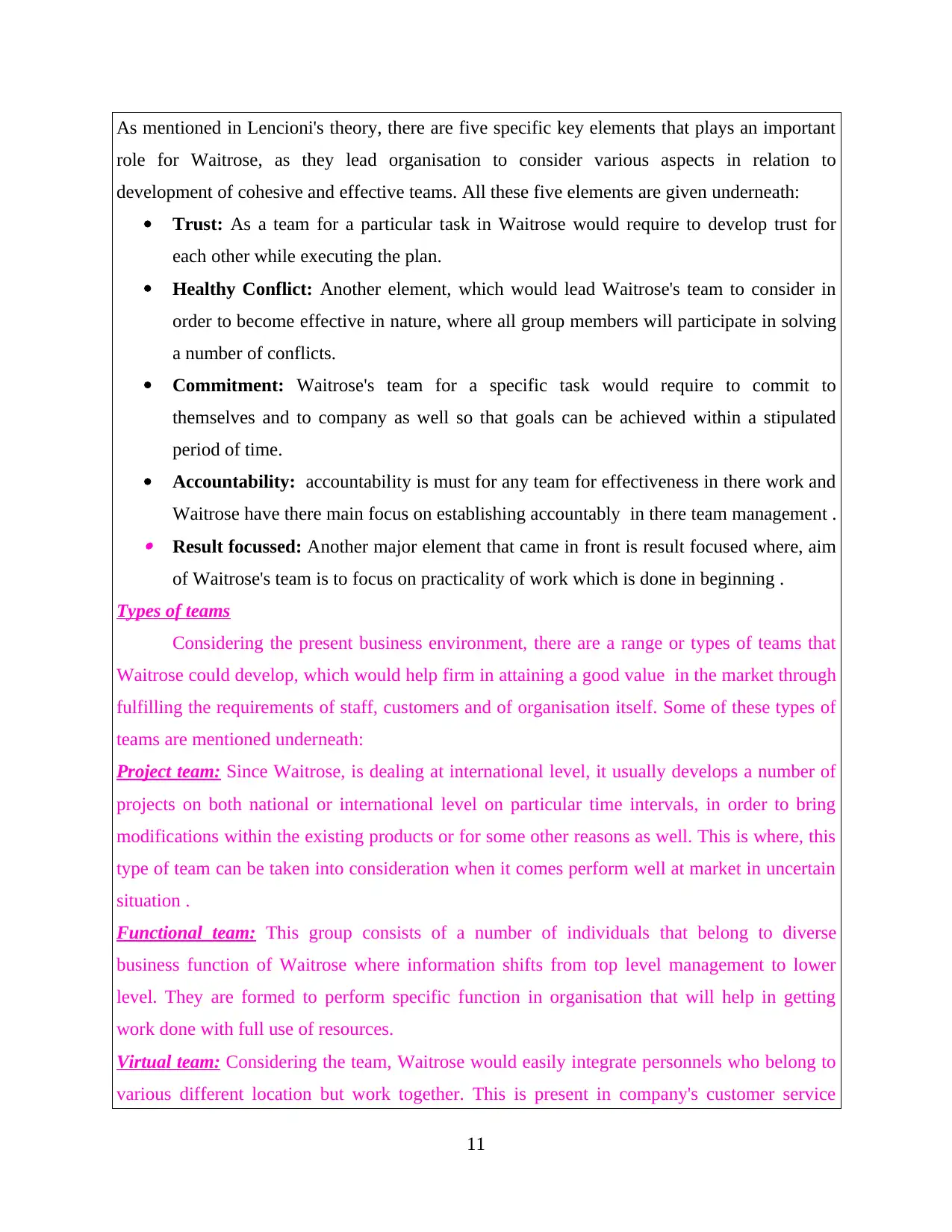
As mentioned in Lencioni's theory, there are five specific key elements that plays an important
role for Waitrose, as they lead organisation to consider various aspects in relation to
development of cohesive and effective teams. All these five elements are given underneath:
Trust: As a team for a particular task in Waitrose would require to develop trust for
each other while executing the plan.
Healthy Conflict: Another element, which would lead Waitrose's team to consider in
order to become effective in nature, where all group members will participate in solving
a number of conflicts.
Commitment: Waitrose's team for a specific task would require to commit to
themselves and to company as well so that goals can be achieved within a stipulated
period of time.
Accountability: accountability is must for any team for effectiveness in there work and
Waitrose have there main focus on establishing accountably in there team management . Result focussed: Another major element that came in front is result focused where, aim
of Waitrose's team is to focus on practicality of work which is done in beginning .
Types of teams
Considering the present business environment, there are a range or types of teams that
Waitrose could develop, which would help firm in attaining a good value in the market through
fulfilling the requirements of staff, customers and of organisation itself. Some of these types of
teams are mentioned underneath:
Project team: Since Waitrose, is dealing at international level, it usually develops a number of
projects on both national or international level on particular time intervals, in order to bring
modifications within the existing products or for some other reasons as well. This is where, this
type of team can be taken into consideration when it comes perform well at market in uncertain
situation .
Functional team: This group consists of a number of individuals that belong to diverse
business function of Waitrose where information shifts from top level management to lower
level. They are formed to perform specific function in organisation that will help in getting
work done with full use of resources.
Virtual team: Considering the team, Waitrose would easily integrate personnels who belong to
various different location but work together. This is present in company's customer service
11
role for Waitrose, as they lead organisation to consider various aspects in relation to
development of cohesive and effective teams. All these five elements are given underneath:
Trust: As a team for a particular task in Waitrose would require to develop trust for
each other while executing the plan.
Healthy Conflict: Another element, which would lead Waitrose's team to consider in
order to become effective in nature, where all group members will participate in solving
a number of conflicts.
Commitment: Waitrose's team for a specific task would require to commit to
themselves and to company as well so that goals can be achieved within a stipulated
period of time.
Accountability: accountability is must for any team for effectiveness in there work and
Waitrose have there main focus on establishing accountably in there team management . Result focussed: Another major element that came in front is result focused where, aim
of Waitrose's team is to focus on practicality of work which is done in beginning .
Types of teams
Considering the present business environment, there are a range or types of teams that
Waitrose could develop, which would help firm in attaining a good value in the market through
fulfilling the requirements of staff, customers and of organisation itself. Some of these types of
teams are mentioned underneath:
Project team: Since Waitrose, is dealing at international level, it usually develops a number of
projects on both national or international level on particular time intervals, in order to bring
modifications within the existing products or for some other reasons as well. This is where, this
type of team can be taken into consideration when it comes perform well at market in uncertain
situation .
Functional team: This group consists of a number of individuals that belong to diverse
business function of Waitrose where information shifts from top level management to lower
level. They are formed to perform specific function in organisation that will help in getting
work done with full use of resources.
Virtual team: Considering the team, Waitrose would easily integrate personnels who belong to
various different location but work together. This is present in company's customer service
11
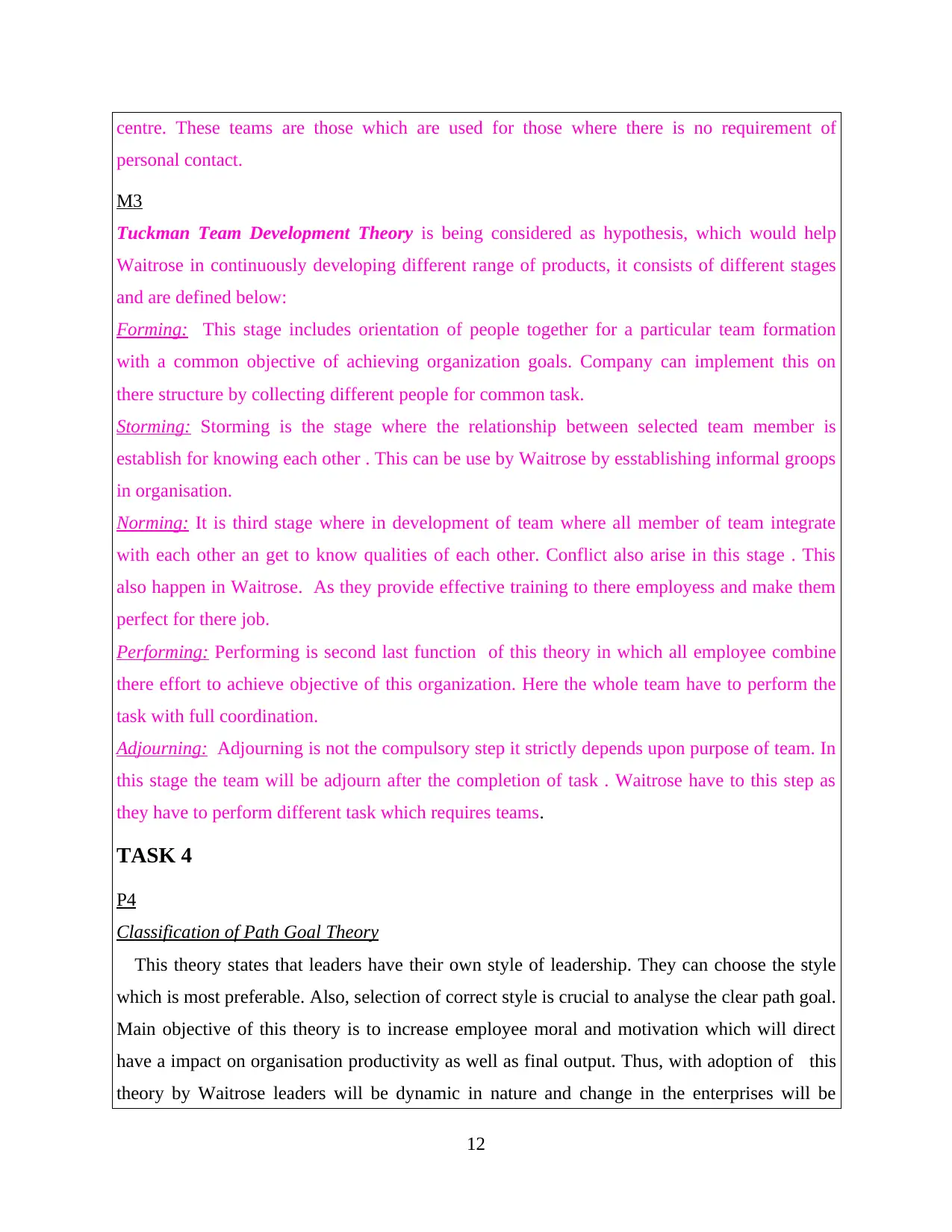
centre. These teams are those which are used for those where there is no requirement of
personal contact.
M3
Tuckman Team Development Theory is being considered as hypothesis, which would help
Waitrose in continuously developing different range of products, it consists of different stages
and are defined below:
Forming: This stage includes orientation of people together for a particular team formation
with a common objective of achieving organization goals. Company can implement this on
there structure by collecting different people for common task.
Storming: Storming is the stage where the relationship between selected team member is
establish for knowing each other . This can be use by Waitrose by esstablishing informal groops
in organisation.
Norming: It is third stage where in development of team where all member of team integrate
with each other an get to know qualities of each other. Conflict also arise in this stage . This
also happen in Waitrose. As they provide effective training to there employess and make them
perfect for there job.
Performing: Performing is second last function of this theory in which all employee combine
there effort to achieve objective of this organization. Here the whole team have to perform the
task with full coordination.
Adjourning: Adjourning is not the compulsory step it strictly depends upon purpose of team. In
this stage the team will be adjourn after the completion of task . Waitrose have to this step as
they have to perform different task which requires teams.
TASK 4
P4
Classification of Path Goal Theory
This theory states that leaders have their own style of leadership. They can choose the style
which is most preferable. Also, selection of correct style is crucial to analyse the clear path goal.
Main objective of this theory is to increase employee moral and motivation which will direct
have a impact on organisation productivity as well as final output. Thus, with adoption of this
theory by Waitrose leaders will be dynamic in nature and change in the enterprises will be
12
personal contact.
M3
Tuckman Team Development Theory is being considered as hypothesis, which would help
Waitrose in continuously developing different range of products, it consists of different stages
and are defined below:
Forming: This stage includes orientation of people together for a particular team formation
with a common objective of achieving organization goals. Company can implement this on
there structure by collecting different people for common task.
Storming: Storming is the stage where the relationship between selected team member is
establish for knowing each other . This can be use by Waitrose by esstablishing informal groops
in organisation.
Norming: It is third stage where in development of team where all member of team integrate
with each other an get to know qualities of each other. Conflict also arise in this stage . This
also happen in Waitrose. As they provide effective training to there employess and make them
perfect for there job.
Performing: Performing is second last function of this theory in which all employee combine
there effort to achieve objective of this organization. Here the whole team have to perform the
task with full coordination.
Adjourning: Adjourning is not the compulsory step it strictly depends upon purpose of team. In
this stage the team will be adjourn after the completion of task . Waitrose have to this step as
they have to perform different task which requires teams.
TASK 4
P4
Classification of Path Goal Theory
This theory states that leaders have their own style of leadership. They can choose the style
which is most preferable. Also, selection of correct style is crucial to analyse the clear path goal.
Main objective of this theory is to increase employee moral and motivation which will direct
have a impact on organisation productivity as well as final output. Thus, with adoption of this
theory by Waitrose leaders will be dynamic in nature and change in the enterprises will be
12
⊘ This is a preview!⊘
Do you want full access?
Subscribe today to unlock all pages.

Trusted by 1+ million students worldwide
1 out of 15
Related Documents
Your All-in-One AI-Powered Toolkit for Academic Success.
+13062052269
info@desklib.com
Available 24*7 on WhatsApp / Email
![[object Object]](/_next/static/media/star-bottom.7253800d.svg)
Unlock your academic potential
Copyright © 2020–2025 A2Z Services. All Rights Reserved. Developed and managed by ZUCOL.





